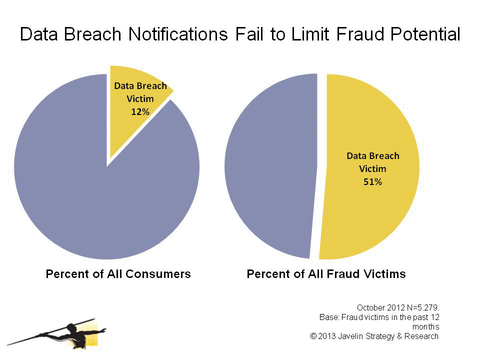 Javelin Strategy Research
Javelin Strategy Research
Half of identity fraud victims in 2012 had also received a data breach notification in the same year, a new report from Javelin Strategy Research finds.
Javelin’s 2013 Data Breach Fraud Impact Report finds that data breaches are increasingly correlated with fraud; if your personal information is compromised in a data breach, you are much more likely to end up being a victim, said Al Pascual, a senior security, risk and fraud analyst at Javelin. The fraud in question usually involves using the stolen information to create a new account in your name, or to gain illegal access to an existing account.
Javelin cites information from the Open Security Foundation, a nonprofit that collects information about data breaches, which found that there were 1,611 breaches in 2012, a 48 percent increase over the prior year. And the impact can be significant. In a case study examined in the report, Javelin calculated that a breach of the South Carolina Department of Revenue, which led to the exposure of 3.6 million Social Security numbers and thousands of payment card numbers, cost affected consumers an average of 20 hours and $776 out of pocket to resolve.
While there is little consumers can do to prevent data breaches at large companies or government agencies, they can take steps to protect themselves if they get a notification of such a breach. But the statistics suggest that consumers aren’t acting when they are informed that their information was compromised, Mr. Pascual said.
“They’re getting notifications, but they’re not acting on them,” he said. “If they were, the numbers would be lower.”
His advice? If you receive a data breach letter, “Don’t just throw it away.”
Rather, he advises, if you receive a notification, there are some steps you should take as a result:
– If you are offered free identity protection services after a breach, use them. The services can help notify you of suspicious activity on your credit report, and offer assistance in resolving any fraud that occurs.
– Contact your bank or credit card company and ask about any potential effect the breach could have on your accounts.
– If your Social Security number is lost or stolen in a breach, placing a fraud alert on your credit report can flag lenders that any application for credit should be given greater scrutiny. A security freeze is a stronger option, as it will prevent any lender from accessing your credit file. But be aware that you will need to remember to lift the freeze temporarily, if you need to seek credit, apply for a job or rent an apartment.
– Monitor your financial accounts by signing up for e-mail or text alerts, which can notify you quickly of any unusual activity, such as an unauthorized funds transfer or a change of address. (According to Javelin, changing the physical address of a bank account occurred in more than half of account takeover frauds, in which a criminal illegally gains access to your bank account).
Have you been notified of a data breach? What steps did you take to protect yourself?
Article source: http://bucks.blogs.nytimes.com/2013/06/06/protecting-yourself-after-a-data-breach/?partner=rss&emc=rss